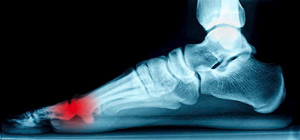Sesamoid bones are unique in that they are not connected to other bones (which is normally the case with bones). Sesamoids are either embedded in muscles or connected to tendons. The kneecap (patella bone) is the largest sesamoid bone in the body. There are two little sesamoids in the foot which help the big toe move, enable the foot to push off, and serve as shock absorbers for the ball of the foot. When these sesamoids become fractured, irritated or inflamed due to repetitive pressure, overuse, or other contributing factors, it is known as sesamoiditis. Sesamoiditis can be quite painful, making it very difficult to walk. If sesamoiditis is not treated properly and promptly, other areas of the foot may become inflamed or even injured. If you are experiencing pain under the big toe and are having difficulty bending and straightening it, consult a podiatrist to see if you have sesamoiditis and receive proper care if you do.
Sesamoiditis is an unpleasant foot condition characterized by pain in the balls of the feet. If you think you’re struggling with sesamoiditis, contact Dr. Mark Gagnon of Advanced Podiatry. Our doctor will treat your condition thoroughly and effectively.
Sesamoiditis
Sesamoiditis is a condition of the foot that affects the ball of the foot. It is more common in younger people than it is in older people. It can also occur with people who have begun a new exercise program, since their bodies are adjusting to the new physical regimen. Pain may also be caused by the inflammation of tendons surrounding the bones. It is important to seek treatment in its early stages because if you ignore the pain, this condition can lead to more serious problems such as severe irritation and bone fractures.
Causes of Sesamoiditis
- Sudden increase in activity
- Increase in physically strenuous movement without a proper warm up or build up
- Foot structure: those who have smaller, bonier feet or those with a high arch may be more susceptible
Treatment for sesamoiditis is non-invasive and simple. Doctors may recommend a strict rest period where the patient forgoes most physical activity. This will help give the patient time to heal their feet through limited activity. For serious cases, it is best to speak with your doctor to determine a treatment option that will help your specific needs.
If you have any questions please feel free to contact one of our offices located in Crestwood, Orland Park, and Summit, IL . We offer the newest diagnostic and treatment technologies for all your foot and ankle needs.

